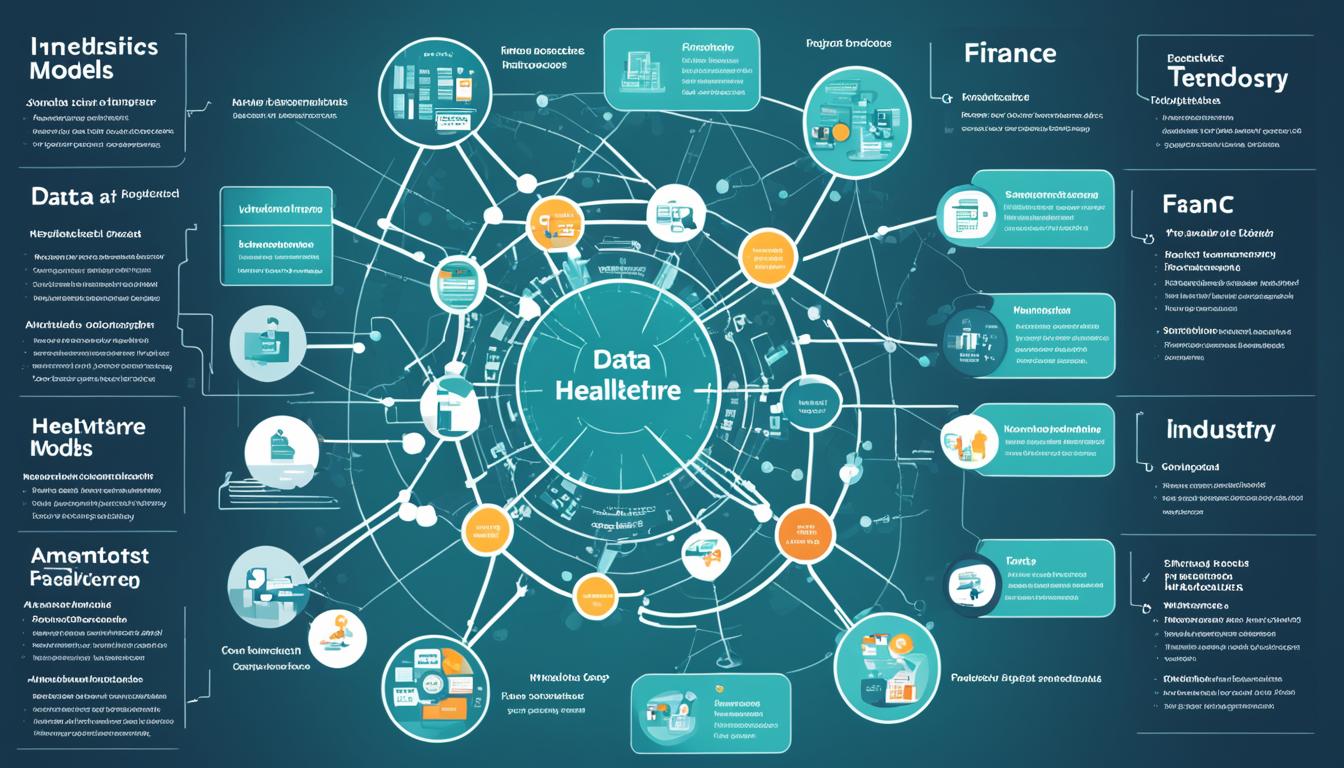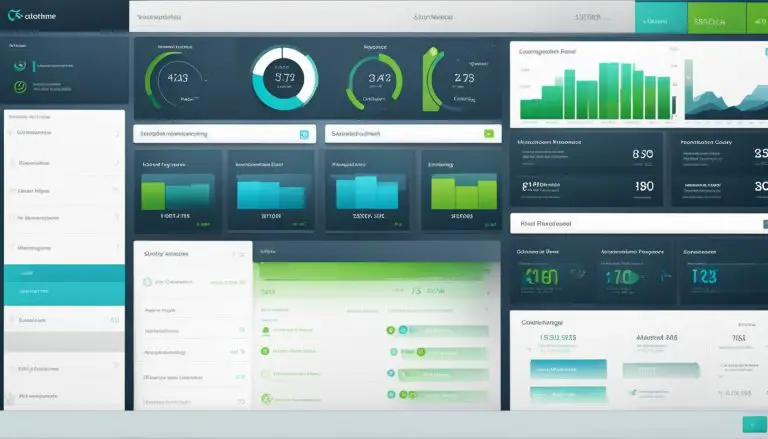What is a Data Model: Understanding Their Role
In the world of data analysis and database management, data models play a crucial role in organizing and structuring data. But what exactly is a data model and why is it important? In this article, I will dive into the concept of data modeling, its significance, different types, techniques, benefits, and best practices. By the end, you’ll have a clear understanding of data models and how they contribute to effective data management and analysis.
Key Takeaways
- A data model is a structured representation of data that helps in understanding its organization and relationships.
- Data modeling is important for improving data quality, optimizing system performance, and facilitating decision-making.
- There are different types of data models, such as conceptual, logical, and physical models.
- Data modeling techniques include entity-relationship diagrams (ERD) and normalized data modeling.
- Benefits of data modeling include enhanced data accuracy, consistency, and integrity.
- Best practices for data modeling involve involving stakeholders, defining entities and attributes, and establishing relationships.
Definition and Importance of Data Modeling
Data modeling is an essential process in the field of database development and system design. It involves creating a structured representation of data to understand its relationship and organization. By organizing and managing data in a structured manner, data modeling provides a foundation for accurate and effective data analysis.
During the data modeling process, the data requirements are defined in a structured manner, ensuring that all relevant information is captured. This structured representation serves as the blueprint for designing a database system that meets the specific needs of an organization. It helps in identifying and establishing relationships between different data entities, allowing for efficient data management and retrieval.
One of the key benefits of data modeling is its role in ensuring data accuracy, consistency, and integrity. By defining the structure and relationships of data entities, data modeling helps in maintaining the accuracy and consistency of data throughout the database system. It also ensures data integrity by enforcing data validation rules, constraints, and referential integrity within the database.
Moreover, data modeling plays a vital role in supporting data analysis and decision-making processes. By providing a structured representation of data, it facilitates data analysis by allowing researchers and analysts to understand the data’s structure and relationship. This enables them to utilize various data analysis techniques and tools to extract valuable insights and make informed decisions.
In summary, data modeling is a crucial step in the database development and system design process. It enables the organizing and managing of data in a structured manner, ensuring data accuracy, consistency, and integrity. Additionally, it supports data analysis and decision-making processes, ultimately contributing to the overall efficiency and effectiveness of an organization’s data management efforts.
| Data Modeling | Benefits |
|---|---|
| Structured representation of data | Efficient data organization and management |
| Data accuracy, consistency, and integrity | Reliable and trusted data |
| Supports data analysis | Valuable insights and informed decision-making |
Overview of the Data Modeling Process
Data modeling plays a crucial role in organizing and structuring data, ensuring data accuracy and integrity, improving database design, enhancing communication and collaboration, supporting system development and maintenance, and facilitating decision-making and analysis. The data modeling process consists of several phases, each serving a specific purpose and contributing to the overall effectiveness of the data model.
Purpose of Data Modeling
The purpose of data modeling is to provide a systematic approach to organizing and structuring data, enabling efficient data management and utilization. By creating a well-designed data model, businesses can ensure data accuracy and integrity, improving the overall quality and reliability of the information stored in a database. Additionally, data modeling enhances database design, optimizing system performance and promoting effective communication and collaboration among stakeholders.
Data modeling is not only essential during the initial stages of system development but also throughout the system’s lifecycle, including maintenance and future enhancements. It enables businesses to make informed decisions based on reliable data analysis, supporting strategic planning and operational efficiency.
The Data Modeling Process
The data modeling process involves several phases, each with its own set of activities and deliverables. These phases include:
- Requirements Gathering: In this phase, stakeholders’ data requirements are identified, and the purpose and scope of the data model are defined. This stage includes gathering information about the data sources, data elements, and the relationships between them.
- Conceptual Data Modeling: This phase focuses on creating a high-level representation of the data model, capturing the essential concepts and relationships. Conceptual data modeling typically involves the use of entity-relationship diagrams (ERD), which depict the entities, attributes, and relationships in the system.
- Logical Data Modeling: During this phase, the conceptual model is transformed into a more detailed and specific representation. The logical data model defines the structure and organization of the data, including tables, columns, primary keys, and foreign keys. This phase also focuses on normalizing the data and ensuring data integrity.
- Physical Data Modeling: In this phase, the logical data model is implemented in a specific database management system (DBMS). Physical data modeling includes defining the physical storage structures, indexing strategies, and other optimizations specific to the chosen DBMS.
Throughout the data modeling process, communication and collaboration with stakeholders are critical. Regular feedback and input from business users, data analysts, and other relevant parties ensure that the data model accurately represents the organization’s data needs and supports the desired outcomes.
| Phase | Activities | Deliverables |
|---|---|---|
| Requirements Gathering | Identifying stakeholders’ data requirements | Documented data requirements |
| Conceptual Data Modeling | Creating an entity-relationship diagram (ERD) | Conceptual data model |
| Logical Data Modeling | Defining tables, columns, primary keys, foreign keys | Logical data model |
| Physical Data Modeling | Implementing the logical model in a specific DBMS | Physical data model |
Phase 1: Requirements Gathering
In the requirements gathering phase, I identify the stakeholders involved in the project and determine their data requirements. This crucial step sets the foundation for the data modeling process and ensures that the final solution aligns with the needs of the organization.
To begin, I engage with key individuals and groups within the organization to understand their roles, responsibilities, and objectives. By identifying stakeholders such as business analysts, subject matter experts, and end users, I can collect valuable insights and perspectives that inform the data modeling process.
Next, I collaborate with the stakeholders to define their data requirements. This involves comprehensively documenting the types of data they need, the attributes they want to capture, and any specific relationships or dependencies between different data elements.
To visually represent the structure and relationships of the data, I create a conceptual data model. This high-level model captures the essence of the data structure and serves as a blueprint for the subsequent stages of data modeling.
“Identifying stakeholders and determining their data requirements is crucial in developing a robust data model. By involving all relevant parties, we ensure that the final solution meets the organization’s needs and enables effective data management and analysis.”
Using entity-relationship diagrams (ERD), I depict the relationships and structures of the database. ERDs provide a clear visualization of how entities (such as customers, products, or transactions) relate to each other and help in identifying entity attributes that further define the data elements.
Defining entities and attributes is a critical step in the requirements gathering phase. This involves establishing the building blocks of the system, determining the specific data elements to be stored, and defining the characteristics of each entity and attribute.
Finally, I establish relationships between the entities to depict the connections and dependencies within the database. This helps in understanding how different data elements interact and ensures the integrity and consistency of the data model.
| Phase | Key Steps |
|---|---|
| Identifying Stakeholders | Engaging with key individuals and groups to understand their roles, responsibilities, and objectives. |
| Determining Data Requirements | Collaborating with stakeholders to comprehensively document the types of data needed and the relationships between data elements. |
| Creating a Conceptual Data Model | Developing a high-level model that visually represents the structure and relationships of the data. |
| Using Entity-Relationship Diagrams (ERD) | Depicting the relationships and structures of the database. |
| Defining Entities and Attributes | Establishing the building blocks of the system and determining the specific data elements to be stored. |
| Establishing Relationships | Defining connections and dependencies within the database to ensure data integrity and consistency. |
By completing the requirements gathering phase, I lay the groundwork for the subsequent stages of data modeling. This comprehensive understanding of stakeholder needs, data requirements, and relationships sets the stage for the logical and physical data modeling phases, enabling the creation of a robust and effective database system.
Phase 2: Logical Data Modeling
In the logical data modeling phase, we take the conceptual model created in the previous phase and convert it into a more detailed and specific structure. This transformation is essential to ensure that the high-level representation can be implemented effectively in a database.
The conversion process involves translating the conceptual model into a concrete data model that reflects the actual structure and organization of the data. One of the key techniques used in logical data modeling is normalized data modeling, which aims to organize the data efficiently and minimize redundancy.
Normalized data modeling involves breaking down the data into multiple tables, with each table representing a specific entity or concept. Within these tables, we define columns to represent the attributes of the entities and establish relationships between the tables. This allows us to create a database schema that accurately represents the relationships and dependencies within the data.
Tables serve as the central building blocks of the logical data model, with each table representing a specific entity or concept. Columns, on the other hand, define the attributes or characteristics of these entities. By defining primary keys, we establish unique identifiers for each row in a table, ensuring data integrity and facilitating efficient data retrieval.
In addition to primary keys, foreign keys are also defined in the logical data model. These keys establish relationships between tables, allowing us to link data across multiple tables and maintain data consistency. Foreign keys serve as references to the primary keys of related tables, enabling us to navigate and retrieve data from connected entities.
Overall, the logical data modeling phase plays a crucial role in refining the conceptual model and transforming it into a detailed and structured data model. Through techniques like normalized data modeling, we can create an efficient and robust database schema that accurately represents the relationships between entities and enables effective data management and analysis.
Example of a Logical Data Model:
| Table Name | Columns | Primary Key | Foreign Key |
|---|---|---|---|
| Customers | CustomerID Name |
CustomerID | N/A |
| Orders | OrderID OrderDate CustomerID |
OrderID | CustomerID (References Customers table) |
| Products | ProductID Name Price |
ProductID | N/A |
| OrderDetails | OrderDetailID OrderID ProductID Quantity |
OrderDetailID | OrderID (References Orders table) ProductID (References Products table) |
The Role of Statistics in Data Science
Data science is a field that heavily relies on statistics to uncover patterns, make predictions, and provide valuable insights. Statistics serves as a fundamental tool in data analysis, enabling data scientists to extract meaningful information and draw significant conclusions from vast amounts of data.
Descriptive analysis is an essential aspect of statistics in data science. It involves summarizing and visualizing data using various statistical measures such as mean, median, and mode. Descriptive analysis helps data scientists gain a comprehensive understanding of the data by examining its central tendencies, distributions, and other key characteristics.
Diagnostic analysis utilizes statistical techniques to identify patterns, relationships, and correlations within the data. It allows data scientists to uncover insights about the factors that influence specific outcomes or behaviors. By exploring the relationships between different variables, diagnostic analysis helps in understanding the underlying mechanisms and making informed decisions.
Predictive analysis is a predictive modeling technique that utilizes statistical models and algorithms to make predictions based on historical data. By analyzing the patterns and trends in the data, data scientists can forecast future outcomes and behavior. Predictive analysis plays a crucial role in various fields, such as finance, marketing, and healthcare, by enabling proactive decision-making and strategic planning.
Prescriptive analysis leverages statistical methods to provide actionable insights and recommendations. It goes beyond predicting future outcomes and focuses on generating optimal solutions to specific problems. Prescriptive analysis helps decision-makers understand the potential effects of different actions or interventions and identify the most effective strategies.
By applying statistical techniques, data scientists can unlock the true potential of data and derive meaningful insights. Statistics serves as a foundation for data analysis and allows organizations to make data-driven decisions, optimize processes, and gain a competitive advantage in today’s data-driven world.
| Statistical Analysis | Description |
|---|---|
| Descriptive Analysis | Summarizes and visualizes data |
| Diagnostic Analysis | Identifies patterns and relationships |
| Predictive Analysis | Uses historical data for predictions |
| Prescriptive Analysis | Provides actionable insights and recommendations |
Comparing Data Science with Other Fields
Data science is often compared to other fields such as data analytics, business analytics, data engineering, machine learning, and statistics. While there are similarities between these disciplines, data science has a broader scope and focuses on extracting insights and making predictions from data.
“Data science takes a multidisciplinary approach to analyzing and interpreting complex data sets, leveraging techniques from statistics, machine learning, and computer science to uncover valuable patterns and trends.”
Data analytics primarily focuses on examining historical data to identify patterns and trends, with a strong emphasis on descriptive and diagnostic analysis. It involves using statistical techniques and visualization tools to understand and communicate the significance of data. On the other hand, business analytics is specifically geared towards optimizing business operations and decision-making processes through data analysis. It involves using data to drive strategic and tactical decisions by leveraging various statistical and quantitative methods.
Data engineering is concerned with the technical aspects of managing and processing large datasets. It involves designing and optimizing data storage systems, data pipelines, and infrastructure to ensure efficient data processing. Data engineers work closely with data scientists to enable the seamless flow of data for analysis and modeling purposes.
Machine learning
is a subfield of data science that focuses on developing algorithms and models that can extract insights and make predictions automatically. It involves training models on historical data, enabling them to learn from patterns and make predictions on new, unseen data. Machine learning techniques play a crucial role in various data-driven applications, such as recommender systems, fraud detection, and natural language processing.
Statistics
is the mathematical foundation of data science. It provides the tools and techniques to analyze data, make inferences, and draw conclusions. Statistics helps in understanding the uncertainty and variability in data, and it forms the basis for hypothesis testing, sampling techniques, and experimental design. Data scientists employ statistical methods to validate their findings and quantify the reliability of their models.
While data science encompasses elements from these different fields, it goes beyond their individual scopes and combines them to extract insights and drive informed decision-making. By leveraging advanced analytics techniques, machine learning algorithms, and statistical methodologies, data scientists are able to discover hidden patterns and make accurate predictions in various domains.

As the interdisciplinary field of data science continues to evolve, it is essential to understand how it differs from other related disciplines. By recognizing the unique value and capabilities of data science, organizations can harness its power to drive innovation, optimize operations, and gain a competitive edge in the modern data-driven landscape.
Conclusion
Data analysis and data visualization are crucial components of data science that work together to extract insights from data and effectively communicate those insights. The importance of data visualization cannot be overstated as it enhances decision-making, improves communication, and enables a better understanding and interpretation of complex data sets.
When it comes to data visualization, there are various tools available in the market such as Tableau, Power BI, and D3.js. These tools allow data analysts to create interactive and visually appealing visualizations that make it easier for stakeholders to comprehend and engage with the data.
By understanding the role of data modeling, organizations can harness the power of data to inform their decision-making processes and gain a competitive edge in the market. Data modeling helps in organizing and structuring data, ensuring data accuracy and integrity, and optimizing database design. With streamlined communication and enhanced data analysis capabilities, organizations can make informed decisions and meet the challenges of a data-driven world.
FAQ
What is data modeling?
Data modeling is the process of creating a structured representation of data to understand its relationship and organization. It helps in defining the data requirements and designing a database system.
Why is data modeling important?
Data modeling is important because it provides a clear understanding of the data and its structure. It helps in capturing the business requirements, ensuring data accuracy, consistency, and integrity. It also plays a vital role in database development, system design, and data analysis.
What is the purpose of data modeling?
The purpose of data modeling is to organize and structure data, ensure data accuracy and integrity, improve database design, enhance communication and collaboration, support system development and maintenance, and facilitate decision-making and analysis.
What are the phases involved in the data modeling process?
The data modeling process involves various phases, including requirements gathering, conceptual data modeling, entity-relationship diagrams (ERD), defining entities and attributes, and establishing relationships.
What happens in the requirements gathering phase of data modeling?
In the requirements gathering phase, stakeholders are identified, and their data requirements are determined. A conceptual data model is created to capture the essence of the data structure. Entity-relationship diagrams (ERD) are used to depict the relationships and structures of the database. Entities and attributes are defined to determine the building blocks of the system, and relationships are established to form connections between entities.
What is logical data modeling?
In the logical data modeling phase, the conceptual model is converted into a more detailed and specific structure. This involves transforming the high-level representation into a concrete data model that can be implemented in a database. Normalized data modeling is used to organize data efficiently and reduce redundancy. Tables, columns, primary keys, and foreign keys are defined to create the database schema.
What is the role of statistics in data science?
Data science relies on statistics to uncover patterns, make predictions, and provide insights. Descriptive analysis helps in summarizing and visualizing data, diagnostic analysis identifies patterns and relationships, predictive analysis uses historical data for predictions, and prescriptive analysis provides actionable insights and recommendations.
How does data science compare to other fields?
Data science is often compared to other fields such as data analytics, business analytics, data engineering, machine learning, and statistics. While there are similarities between these disciplines, data science has a broader scope and focuses on extracting insights and making predictions from data.
What is the importance of data visualization in data science?
Data analysis and data visualization are interconnected components of data science that play a crucial role in extracting insights from data and communicating those insights effectively. Proper data visualization enhances decision-making, improves communication, and allows for better understanding and interpretation of complex data sets. Various data visualization tools, such as Tableau, Power BI, and D3.js, can be used to create interactive and visually appealing data visualizations.
- About the Author
- Latest Posts
Janina is a technical editor at Text-Center.com and loves to write about computer technology and latest trends in information technology. She also works for Biteno.com.






